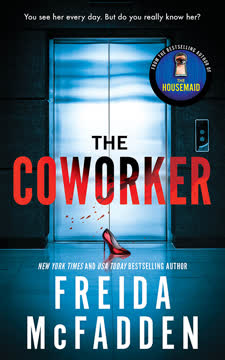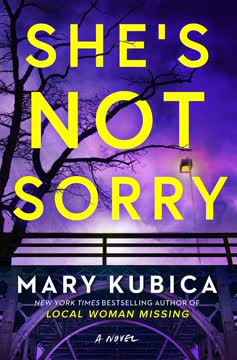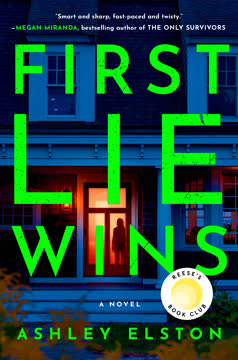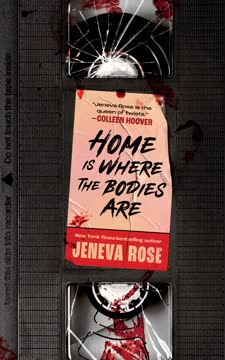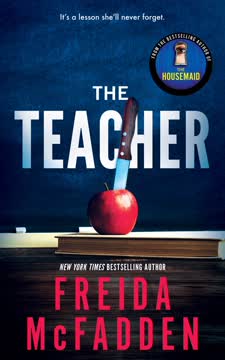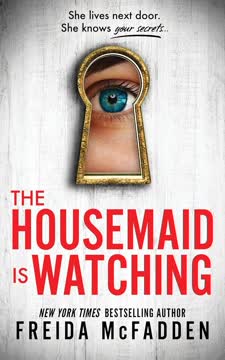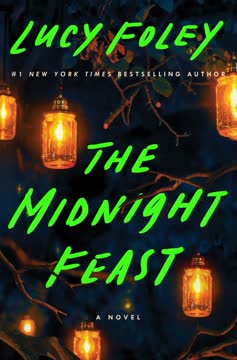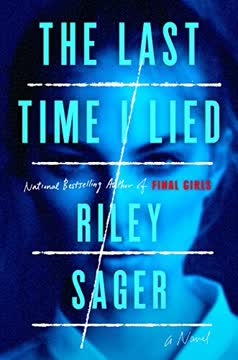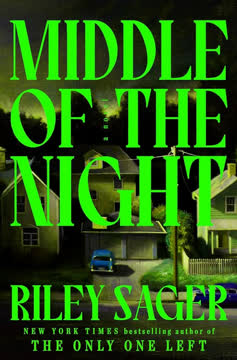Plot Summary
Caregiver's Return to Shadows
Kit, a caregiver recently suspended after her mother's controversial death, is desperate for work and reluctantly accepts a job at Hope's End, a decaying mansion perched on Maine's cliffs. Her reputation is tarnished, her father is cold, and her only solace is in books and fleeting encounters. The assignment is to care for Lenora Hope, a mute, paralyzed woman infamous for allegedly murdering her family decades ago. Kit's own guilt and the town's suspicion mirror the shadow of Lenora's legend. As Kit packs her meager belongings and leaves her father's silent house, she's haunted by the question: is she, too, capable of the darkness others see in her?
Hope's End Beckons
Kit's journey to Hope's End is both literal and psychological, as she drives along the windswept coast to the mansion that looms over the town's collective memory. The house is grand but crumbling, its opulence faded, its reputation stained by the Hope family massacre. Kit is greeted by the severe housekeeper, Mrs. Baker, and meets the eccentric staff: Archie the cook, Jessie the maid, and Carter the groundskeeper. The house's tilt and decay mirror Kit's own instability. She's introduced to Lenora, a ghostly figure in a wheelchair, whose green eyes seem to hold secrets and accusations. Kit senses she's entered not just a new job, but a living legend—a place where the past is never truly dead.
The Legend of Lenora
Kit learns the chilling rhyme that has haunted the town for decades: "At seventeen, Lenora Hope / Hung her sister with a rope / Stabbed her father with a knife / Took her mother's happy life." The story is both myth and memory, with Lenora as the town's bogeyman. Kit's own past—her mother's death by overdose, her father's silent judgment—echoes the suspicion that clings to Lenora. The mansion is filled with reminders: portraits shrouded in black, bloodstains on the stairs, and the ever-present ocean below. Kit is both repelled and fascinated, drawn into the mystery of what really happened that night, and whether Lenora is a monster or a victim.
Entering the Prison
Kit is indoctrinated into the rigid routines of Hope's End. Mrs. Baker enforces strict rules, including a nurse's uniform and a ban on taking Lenora outside. The staff is wary, the house oppressive, and Kit's room is filled with the belongings of Mary, the previous nurse who vanished without a trace. Kit's interactions with Lenora are fraught with tension—she's both caretaker and potential confessor, unsure whether to fear or pity her patient. The house's physical tilt becomes a metaphor for the psychological unease that pervades every interaction. Kit senses that everyone is hiding something, and that she, too, is being watched and judged.
The House of Secrets
Kit's curiosity grows as she explores the mansion and its inhabitants. She bonds with Jessie, who gives her a "murder tour" of the house, pointing out where each family member died. The staff is a web of secrets: Archie's loyalty, Carter's mysterious past, and Mrs. Baker's iron control. Kit discovers that Mary, the missing nurse, was obsessed with the Hope murders and had been helping Lenora type her story. The house is filled with hidden passages, locked doors, and the constant threat of the ocean below. Kit's own guilt over her mother's death is mirrored in the house's atmosphere of accusation and denial.
The Silent Patient
Lenora, unable to speak or move except for her left hand, communicates through taps and, eventually, the typewriter. With Kit's help, she begins to type her story—fragmented, haunting, and ambiguous. Lenora claims innocence and guilt in equal measure, her memories clouded by trauma and time. The act of typing becomes both confession as catharsis and weapon, as Kit is drawn deeper into Lenora's narrative. The boundary between caretaker and confessor blurs, and Kit begins to question her own reliability and motives. The typewriter is both a lifeline and a weapon, capable of revealing or obscuring the truth.
Nightmares and Confessions
Kit is plagued by nightmares—her mother's death, the town's suspicion, and the echo of Lenora's alleged crimes. The house creaks with unexplained noises, shadows move in the night, and Kit suspects someone is entering Lenora's room. The boundary between past and present blurs, as Kit's own guilt and fear mirror Lenora's isolation. The two women form a tentative bond, united by their status as pariahs and their need for absolution. Kit confesses her role in her mother's death, and Lenora offers her own ambiguous confessions. The house becomes a crucible, forcing both women to confront the darkness within themselves.
The Weight of Guilt
The discovery of Mary's body at the base of the cliff shatters the fragile equilibrium of Hope's End. The police, led by Detective Vick, suspect suicide, but Kit is convinced it was murder. The staff is thrown into suspicion—anyone could be the killer, and everyone has a motive. Kit's investigation reveals that Mary was close to uncovering the truth about the Hope murders, and that her death is linked to the secrets the house is desperate to keep. The cycle of accusation and denial intensifies, as Kit realizes that the past is not just haunting the present—it is actively destroying it.
The Murder Tour
Kit retraces Mary's steps, interrogates the staff, and uncovers a web of lies and half-truths. The house's history is revealed in layers: affairs, betrayals, and the slow erosion of hope. Kit discovers that Lenora was pregnant at the time of the murders, that the staff is being blackmailed, and that the missing nurse's belongings hold crucial clues. The physical decay of the house mirrors the unraveling of its inhabitants' alibis. Kit's own sense of self is shaken, as she realizes she is both detective and suspect, caretaker and potential victim.
The First Death
Through Lenora's typed confession and Kit's investigation, the events of the night of the murders are revealed. The Hope family was a powder keg of secrets: Lenora's pregnancy, her affair with a servant, her father's cruelty, and her mother's addiction. The murders were not the work of a single monster, but the tragic culmination of years of repression and betrayal. Lenora's sister, Virginia, played a crucial role—her suicide attempt was mistaken for murder, and Lenora's silence became both shield and prison. The truth is more complicated and heartbreaking than the legend.
Ghosts in the Hallway
As the house literally begins to collapse—cracks in the walls, the terrace falling into the sea—the psychological pressure on the characters reaches a breaking point. Kit confronts her father, who is revealed to be both a victim and a perpetrator, complicit in the cycle of violence that destroyed the Hope family. The staff's secrets are laid bare, and the boundary between past and present dissolves. The house's final collapse is both literal and symbolic—a reckoning for decades of silence, guilt, and denial. Kit and Virginia escape, but not unscathed.
The Pact of Silence
In the wake of the collapse, Kit and Virginia must forge new lives. The truth about the Hope family murders is finally revealed to the world, but the cost is immense. Kit reconciles with her father, confesses her own guilt, and begins to heal. Virginia, freed from her sister's shadow, is able to reclaim her identity and seek out the child she lost. The survivors form a new, unconventional family, united by their shared trauma and their refusal to be defined by the past. The legend of Lenora Hope is rewritten—not as a monster, but as a victim of circumstance and silence.
The Typewriter's Truth
The typewriter, once a tool of confession as catharsis and weapon, becomes a symbol of agency and redemption. Virginia writes her memoir, reclaiming her voice and her story. Kit, too, finds solace in writing, using her experience to help others. The act of storytelling is both catharsis and resistance—a way to break the cycle of silence and shame. The legend of Hope's End is transformed, not by denial, but by the courage to speak the truth. The survivors are able to move forward, not by forgetting the past, but by understanding and owning it.
The Missing Nurse
Mary's death is both a tragedy and a warning—the cost of knowing too much in a house built on secrets. The staff's complicity is revealed: blackmail, betrayal, and the desperate need to survive. Kit realizes that survival often comes at the expense of others, and that the line between victim and perpetrator is often blurred. The house's collapse is not just physical, but moral—a reckoning for decades of silence and complicity. The survivors must confront the consequences of their actions, and decide what kind of future they want to build.
The Cliff Cracks
As the house teeters on the edge of destruction, the characters are forced to confront their deepest fears and desires. Kit's father returns, seeking redemption and revenge. Virginia must choose between silence and confession, between survival and truth. The staff's loyalties are tested, and the house's secrets are finally exposed. The collapse of Hope's End is both an ending and a beginning—a chance to break free from the past and forge a new future. The survivors escape, but the scars of the past remain.
The Baby and the Blood
In the aftermath, Kit and Virginia search for the child taken from Virginia decades ago. The quest is both literal and symbolic—a search for lost innocence, for the possibility of forgiveness and healing. The survivors form a new family, united by their refusal to be defined by the past. The legend of Hope's End is rewritten, not as a story of monsters and victims, but as a testament to the power of truth, love, and survival. The final chapter is one of hope, not despair.
The Real Lenora
The final twist reveals that the woman known as Lenora is actually Virginia, and that the real Lenora has been living as Mrs. Baker. The legend is upended, and the truth is more complicated than anyone imagined. The survivors must come to terms with their true identities, and decide what kind of future they want to build. The story ends not with vengeance, but with understanding—a recognition that the past cannot be changed, but the future is still unwritten.
The Final Collapse
Hope's End is gone, but its survivors remain. Kit and Virginia, freed from the weight of the past, are able to build new lives. The legend of Lenora Hope is finally laid to rest, not as a story of horror, but as a testament to the resilience of the human spirit. The survivors are able to forgive, if not forget, and to move forward with hope. The story ends with the possibility of healing, and the recognition that even in the darkest places, there is still the chance for redemption.
Characters
Kit McDeere
Kit is the novel's protagonist, a caregiver whose life is defined by guilt, suspicion, and the need for absolution. After her mother's death by overdose—a tragedy for which she is blamed—Kit is ostracized by her father and community. Her assignment at Hope's End is both punishment and opportunity, as she is drawn into the house's web of secrets. Kit is intelligent, empathetic, and deeply wounded, her sense of self shaped by the judgments of others. Her relationship with Lenora/ Virginia is complex—part confessor, part detective, part surrogate daughter. Over the course of the novel, Kit confronts her own guilt, learns to forgive herself, and becomes a catalyst for the truth's emergence. Her journey is one of self-discovery, as she moves from passive victim to active agent of change.
Lenora Hope (Mrs. Baker)
Lenora, the infamous "murderess" of Hope's End, is revealed to be living as Mrs. Baker, the housekeeper. She is cold, calculating, and fiercely protective of her own survival. Lenora's decision to swap identities with her sister, Virginia, is both an act of self-preservation and a profound betrayal. She is haunted by guilt, but also by resentment—her life defined by the legend she cannot escape. Lenora's relationship with Virginia is fraught with rivalry, regret, and a twisted sense of loyalty. She is both jailer and victim, her actions driven by a desperate need to control her own narrative. In the end, Lenora's willingness to let the truth emerge is both her undoing and her redemption.
Virginia Hope (the "Lenora" patient)
Virginia, long thought dead, has been living as the mute, paralyzed "Lenora" for decades. Her silence is both imposed and chosen—a way to survive, to punish her sister, and to wait for the possibility of reunion with her lost child. Virginia is intelligent, sensitive, and deeply traumatized, her life shaped by betrayal, loss, and the weight of secrets. Her relationship with Kit is transformative—Kit is the first to truly see her, to treat her as a person rather than a legend or a burden. Virginia's eventual confession is an act of courage, reclaiming her voice and her agency. Her journey is one of survival, forgiveness, and the hope of healing.
Archie
Archie is the cook and longtime staff member at Hope's End, a figure of stability and quiet strength. His loyalty to Virginia is unwavering, rooted in a deep, platonic love and shared history. Archie is a survivor, having endured decades of secrets, betrayals, and the slow decay of the house. He is both complicit and innocent, his silence a form of protection for those he loves. Archie's own secret—his relationship with Ricardo Mayhew—adds depth to his character, revealing the ways in which love and loyalty can both save and destroy. In the end, Archie is a bridge between past and present, helping Kit and Virginia forge a new family.
Jessie
Jessie, the young maid with a rebellious streak, is revealed to be Virginia's granddaughter, the child of the son taken from her decades ago. Jessie's presence at Hope's End is both accidental and intentional—a quest to uncover her family's history and to connect with the grandmother she never knew. She is resourceful, compassionate, and determined, her youthful energy a counterpoint to the house's decay. Jessie's secret communication with Virginia, and her role in the final escape, are acts of love and defiance. She represents the possibility of healing and the hope of a future unburdened by the past.
Carter
Carter, the groundskeeper, is a man searching for his own place in the world. Believing himself to be Lenora's grandson, he is drawn to Hope's End by the promise of answers and inheritance. Carter is kind, capable, and haunted by the need to belong. His relationship with Kit is marked by mutual respect and shared trauma. Carter's discovery that he is not, in fact, related to the Hopes is both a loss and a liberation—he is free to define himself on his own terms. His role in the final crisis is both redemptive and tragic, as he helps Kit and Virginia escape the house's collapse.
Mary Milton
Mary, the previous nurse, is a figure of curiosity and tragedy. Her obsession with the Hope murders leads her to uncover the truth, but also to her death. Mary is intelligent, empathetic, and determined, her relationship with Lenora/ Virginia marked by genuine care and a shared need for understanding. Her death is both a warning and a catalyst, forcing Kit to confront the dangers of knowing too much in a house built on secrets. Mary's legacy is the typed confession she helps Virginia create—a testament to the power and peril of truth.
Pat McDeere (Ricky)
Pat, Kit's estranged father, is a man defined by regret, guilt, and the need to protect his own secrets. His role in the Hope family tragedy is both direct and indirect—he is Virginia's lover, the father of her child, and the man who ultimately kills Mary to protect himself. Pat's relationship with Kit is fraught with silence, disappointment, and a desperate need for forgiveness. His confession is both a relief and a devastation, forcing Kit to confront the reality of her own family's darkness. Pat is both victim and perpetrator, a man destroyed by the very secrets he tried to keep.
Detective Vick
Detective Vick is the police officer assigned to both Mary's death and the original Hope murders. He is skeptical, methodical, and burdened by his own history with Hope's End. Vick's refusal to believe Kit, and his insistence on seeing the world in black and white, is both a source of frustration and a reflection of the town's collective denial. He represents the limits of official justice in a world where the truth is slippery and the past refuses to stay buried.
Mrs. Baker (the real one)
The real Mrs. Baker, long gone from Hope's End, is a figure whose absence shapes the story. Her role as Lenora's tutor, her affair with Winston Hope, and her decision to take Virginia's child and raise him as her own are acts of both betrayal and salvation. Mrs. Baker's legacy is the web of secrets she leaves behind, and the possibility of redemption she offers through her care for Virginia's son. She is both villain and savior, a reminder that survival often comes at the expense of others.
Plot Devices
Dual Narratives and Unreliable Memory
The novel employs a dual narratives and unreliable memory structure, alternating between Kit's present-day investigation and Lenora/ Virginia's typed confession. This structure allows for the gradual revelation of secrets, as past and present inform and complicate each other. The use of unreliable narrators—Kit, haunted by guilt; Lenora/ Virginia, hiding her true identity—creates a sense of ambiguity and suspense. The reader is forced to question what is true, what is legend, and what is self-serving revision. The typewriter is both a literal and symbolic device, representing the power of storytelling to both reveal and obscure the truth.
Gothic Setting and Symbolism
Hope's End is more than a setting—it is a character in its own right. The house's physical decay, its tilt toward the sea, and its history of violence mirror the psychological states of its inhabitants. The house is a prison, a crucible, and a stage for the enactment of generational trauma. The ocean below represents both danger and escape, the possibility of oblivion and the hope of freedom. The recurring motifs of blood, water, and broken glass reinforce the themes of guilt, memory, and the impossibility of true closure.
Foreshadowing and Red Herrings
The novel is rich in foreshadowing and red herrings—cracks in the walls, missing objects, unexplained noises—that hint at both literal and metaphorical collapse. Red herrings abound: the suspicion cast on various staff members, the legend of Lenora, the possibility of supernatural intervention. These devices keep the reader (and Kit) guessing, heightening the sense of paranoia and uncertainty. The final revelations are both surprising and inevitable, the result of careful narrative construction and psychological insight.
Confession as Catharsis and Weapon
Confession as catharsis and weapon is central to the novel's structure and themes. The act of typing one's story is both a means of reclaiming agency and a way of inflicting pain. The truth, once revealed, is both liberating and devastating—capable of healing old wounds and creating new ones. The novel explores the limits of confession: what can be forgiven, what must be lived with, and what can never be undone. The final act of storytelling is both an ending and a beginning, a way to move forward without forgetting the past.
Analysis
Riley Sager's The Only One Left is a masterful reimagining of the Gothic thriller, blending psychological suspense with a meditation on guilt, survival, and the corrosive power of secrets. At its core, the novel interrogates the stories we tell about ourselves and others—the legends that become prisons, the confessions that both heal and harm. Through its dual narratives and unreliable memory and shifting perspectives, the book explores the ways in which trauma is inherited, denied, and ultimately confronted. The decaying mansion of Hope's End is both a literal and symbolic space, a crucible in which the characters' identities are forged and destroyed. Sager's use of unreliable narrators, foreshadowing and red herrings, and carefully planted clues sustains a sense of dread and ambiguity, forcing the reader to question the nature of truth and justice. The novel's ultimate message is one of hard-won hope: that even in the darkest places, the act of telling the truth—however painful—can be a form of redemption. The survivors are not unscathed, but they are free to write new stories, unburdened by the legends of the past.
Last updated:
Review Summary
The Only One Left receives mostly positive reviews, with many praising its gothic atmosphere, compelling plot, and unexpected twists. Readers appreciate the creepy setting of Hope's End mansion and the intriguing mystery surrounding Lenora Hope. Some criticize the abundance of plot twists and unrealistic elements, particularly in the final act. While opinions vary, many consider it one of Sager's best works, noting its addictive storytelling and well-developed characters. The audiobook narration is highly praised. Overall, it's recommended for fans of suspenseful thrillers with gothic elements.
Similar Books
Download PDF
Download EPUB
.epub digital book format is ideal for reading ebooks on phones, tablets, and e-readers.

